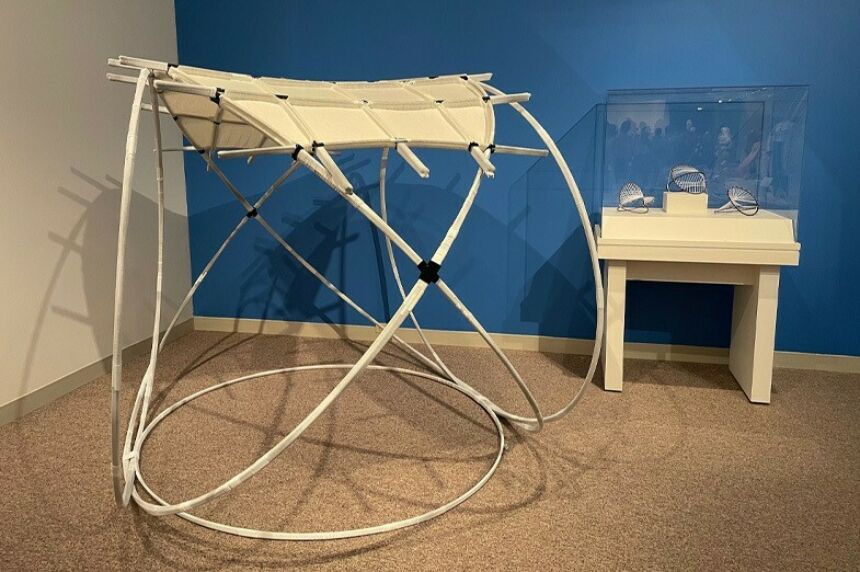October 03, 2023
Penn State-led sustainable building materials research showcased in exhibition

UNIVERSITY PARK, Pa. — An interdisciplinary research project led by Penn State Stuckeman School researchers and architecture faculty members Felecia Davis and Benay Gürsoy that explores the use of biomaterials and knitted textiles as sustainable building materials is featured in the “Knitting Beyond the Body” exhibition at the Kent State University Museum from Sept. 29 through Aug. 1, 2024.
Their collaborative project, titled “MycoKnit,”uses mycelium – which is the root of fungi – and knitted fabric as lightweight and biodegradable composite structures that together make a strong and lightweight building material. Ali Ghazvinian and Farzaneh Oghazian, who both recently graduated from Penn State with doctorates in architecture, are co-leads on the project. Ghazvinian is now an assistant professor in the Huckabee College of Architecture at Texas Tech University and Oghazian holds the same position in the College of Art and Design at Louisiana State University.
Davis and Gürsoy are both researchers in the Stuckeman School's Stuckeman Center for Design Computing (SCDC) in the College of Arts and Architecture. Davis directs the Computational Textiles Lab (SOFTLAB), which looks at how lightweight and soft computational materials and computational textiles are made and how they can be applied in architecture, furnishings and clothing. As director of the Form and Matter Lab (ForMat Lab), Gürsoy's team explores the relationship between matter and form mediated through the use of digital technologies. Current research in the lab includes work on adaptive digital fabrication, and the design and sustainable fabrication of mycelium-based building parts and structures.
The MycoKnit project is an evolution of both Davis and Gürsoy's advances in their respective labs to explore the use of knitted textiles as a framework and reinforcement system to develop fiber composite mycelium-based architectural structures.
“Mycelium-based composites and knitted textiles made of natural yarns are both organic systems, and when integrated, can offer a sustainable and biodegradable material and structural system that is strong in both tension and compression,” said Gürsoy, assistant professor of architecture. “By exploring the interrelated behavior of mycelium-based composites and knitted textiles where the knit is used as a growing base for mycelium materials, our goal is to enable a lightweight and biodegradable building material and structural system.”
For the Kent State exhibition, the team is showcasing a MycoKnit gridshell structure that integrates bending active elements comprised of fiberglass tent poles and industrial knit panels that were fabricated on a Shima Seiki Computerized Flatbed Machine.
“We added living mycelium-based mixtures into the panels that were shaped by the gridshell and gravitational forces,” explained Davis, associate professor of architecture. “Our first attempt at this resulted in some mold growing but we are in the process of reloading this gridshell system with new mycelium-based mixtures and will experiment with some solutions to prevent mold growth.”
The textiles are knitted with 100% undyed wool yarn using an industrial knitting machine. Both the knitted textiles and the mycelium-based composite components of the structure are fully biodegradable. The flexible, hollow fiberglass tent poles, on the other hand, can be reused to fabricate similar forms and are easily stored.
In addition to Davis, Gürsoy, Ghazvinian and Oghazian, the core members of the research team include John Pecchia, associate research professor in the College of Agricultural Sciences' Department of Plant Pathology and Environmental Microbiology and manager of the Mushroom Research Center at Penn State; Andre West, associate professor and director of The Zeis Textiles Extension at the Wilson College of Textiles at North Carolina State University; and Jenna DeCandio, manager of the Knit Lab at NC State.
Other members of the Penn State team are Paniz Farrokhsiar, architecture doctoral candidate and ForMat Lab researcher; Parachi Masown, recent bachelor of architecture alumna; Alale Mohseni, architecture doctoral student and ForMat Lab researcher; Katy Gerace, material science and engineering doctoral alumna; and Tahmures Ghiyasi, who recently earned his master's degree in architectural engineering at Penn State and is now pursuing his doctorate at Texas Tech.
MycoKnit is supported by the Skidmore Owings & Merrill (SOM) Foundation Research Prize and the SCDC.